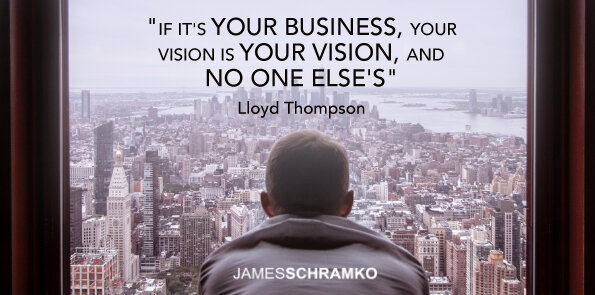Podcast: Download (Duration: 29:41 — 27.9MB)
Get Notified Of Future Episodes Apple Podcasts | Spotify | Amazon Music | Android | Blubrry | Gaana | TuneIn | Deezer | Anghami | RSS | More
Lloyd Thompson has a lot of experience with business owners and the challenges they face in communicating their visions to their teams. Lloyd, who runs virtualdoo.com, helps visionaries realize their goals with the aid of people and systems.
In this podcast episode, James chats with Lloyd about how to develop a mission and vision statement.
Are the benefits of actually writing vision statements real or perceived?
Does a vision for business genuinely help to focus a team’s energy, or is it just flowery words and hot air?
And if you have a vivid vision, how can you achieve it more effectively in your business? James and Lloyd explore.
Table of contents
1. The difference when you tell the team
2. How do you do your visioning?
3. Putting people on a mission
4. No statement, but all action
5. The categories involved
6. Getting everyone to buy in
7. Why repelling is also important
8. Does your team know your goals?
9. What Lloyd does to fix things
10. Has Lloyd ever failed to help?
11. The ultimate takeaways…
The difference when you tell the team
How important is it, James opens, to share your vision of your business with your team?
Lloyd has seen cases where the vision does exist in company documentation but is either outdated or unknown to the team, and this results in a lack of alignment and purpose. Frustration ensues and time is wasted as the business owner has to step in to clarify priorities that could have been explained by the vision document.
James has had experience in past jobs and in his current business with various ways of communicating vision. He’s seen it done in both corporate and small business settings, employing a variety of tools – vision statements, values workshops, slogans, Gantt charts, and even Draconian rules with penalties for non-compliance.
How do you do your visioning?
Lloyd, too, can discuss different approaches to visioning. He mentions, for instance, the classic approach of having a vision and mission statement, as exemplified by Tesla. His own preferred approach is having a vivid vision – a multi-page manifesto that includes detailed information about the business, its goals, values, and what it will look like and feel like in three years. This document can be shared internally and externally, aligning not only the team but also clients and vendors with the company’s vision and values.
It’s the Cameron Herold model, says James. Lloyd affirms this. He goes on to say that he likes to include the founder’s goals in the document as well. He relates this approach to Maxwell Maltz’s Psycho-Cybernetics, explaining that by visualizing the business in detail, you are programming the subconscious, which is a key element of Maltz’s approach.
Lloyd believes that the vivid vision is a powerful artifact to share, and is incredibly effective as it provides a detailed and comprehensive vision of the future of the business, aligning and empowering all stakeholders to work towards that vision.
This approach not only helps the founder to clarify their vision but also helps the entire team to understand and buy into that vision, making it more likely that the business will achieve its goals.
Putting people on a mission
Lloyd and James agree that people want to be part of a mission and understand the greater picture, rather than just being assigned tasks. It’s the old story of two bricklayers, one of whom sees himself as laying a wall while the other says he’s building a cathedral. It highlights the importance of understanding the ‘why’ and the emotional impact of the work.
Our experts look at Tesla’s mission statement: to create the most compelling car company of the 21st century by driving the world’s transition to electric vehicles. It’s powerful, says Lloyd, but – it lacks emotion, James puts in. Many mission statements, he notices, use big, flowery words but fail to connect with people on an emotional level, leading to a disconnect between the company’s stated mission and what it actually means to its employees.
No statement, but all action
James’s approach to helping his small team understand their purpose and goals is achieved through two documents. The first document visually outlines the online ecosystem of his business, from traffic generation to content creation and distribution, customer engagement, and offer presentation. The second document shares his personal journey from employment to self-employment, the reasons behind it, the types of people they help, and how they help them.
James explains that he shares his personal journey, from being a debt collector to running his own business, with his team to help them understand the ‘why’ behind his business. He describes the emotional journey of transitioning from employment to self-employment and the desire to protect himself from doom and catastrophe. He then explains the ‘what’ of his business, the online ecosystem he has created, and the ‘who,’ the three main types of customers they help.
James goes on to describe the ‘how’ of his business, explaining how they help their customers improve themselves, build a team, find leverage with the right business model, and ultimately be successful and enjoy the same benefits he has achieved – fun, health, freedom, the ability to work wherever they want, and to have a business model that’s exciting and interesting.
James emphasizes that he does not have a written mission statement but instead focuses on explaining the purpose, goals, and methods of his business to his team in a more personal and meaningful way.
The categories involved
James and Lloyd discuss the importance of creating a vivid vision for different areas of a business, such as sales, marketing, IT, operations, and finance, to share with the team.
Lloyd suggests that even small operations with a few people should think about the events they are running, the customers they are serving, the culture and values of the team, and how they all interact. The vision document, he says, should paint a clear picture of what it looks and feels like to be in the business in three years, considering all interactions, vendors, and whether clients align with the business.
Doesn’t that seem too “enterprise-y” for a small operation, asks James? Lloyd reassures him that even small businesses can benefit from creating a vivid vision that details the culture and values of the team, how they interact and share knowledge, and the overall experience of the business.
Lloyd explains that this comprehensive approach helps to align the team and ensure that everyone is working towards the same goals.
Getting everyone to buy in
There are challenges, James and Lloyd know, in communicating a vision to a team in a way that makes them feel invested and included.
Lloyd shares a consultative approach used by his brother in the education space, which involves talking to everyone on the team, surveying customers, and then bringing that information to the founders or directors to create a document.
Lloyd stresses, however, that ultimately the vision of the business is the owner’s, and while it’s fine to take input from the team, it’s the primary role of the visionary to create the vision and to share that vision with the team to get them invested and excited about it.
Why repelling is also important
It’s important, too, says Lloyd, that a vision not only attracts people who align with it but also repels those who don’t. It’s crucial to know who is repelled by your vision because they won’t work well in your business, and it’s better to attract clients and team members who want the same things as you do.
There’s a social media influencer, for instance, who has a controversial approach and a large following. While James may not agree with his ideas, Lloyd supposes the guy has found his tribe, despite repelling many others.
James acknowledges the influencer’s abrasiveness – “If you don’t have a six pack, you’re not working in my company,” works for a certain audience. In his own business, James sees the importance of respecting his team’s preferences and creating an inclusive environment.
Does your team know your goals?
James wonders if his team would be able to articulate the goals and values of his business, in his absence. He certainly hopes their understanding aligns with his own vision.
Lloyd agrees this is a good test and clarifies that by “goals,” he doesn’t necessarily mean financial ones. He explains that while some financial information, like sales numbers, can be shared, other details, like personal income or other employees’ salaries, can remain private.
The vision document, says Lloyd, should help team members reverse engineer how to implement the owner’s dream, focusing more on the qualitative aspects, like what the business feels like and who the clients are, rather than quantitative measurables.
Lloyd further explains, however, that while the vision document focuses on qualitative aspects, team members can use it to create relevant quantitative goals for the current year or quarter. Knowing the long-term vision, they can set measurable goals in areas like sales, marketing, IT, and operations. This approach enables the team to work towards the owner’s dream while setting and measuring relevant short-term aims.
What Lloyd does to fix things
When a business owner is frustrated that their team cannot read their mind and automatically do everything they envision, Lloyd begins by asking them to paint a picture of what “good” would look like, and describe their current challenges. He then conducts a more detailed assessment to determine if the team is aware of the owner’s pains and challenges.
Lloyd not only asks the founder about the challenges and pains but also surveys the team members to understand what is working well and what common pains need to be addressed.
The initial assessment, says Lloyd, typically takes about a month. During this time, he and his team conduct interviews, examine processes, and share interim findings with the business owner weekly. At the end of the assessment, they provide a roadmap of suggested actions to fix identified issues and offer to implement the changes if the business owner desires.
Lloyd stresses the importance of starting with understanding the current state, the desired state, and the pain points. While it would be ideal for business owners to conduct this assessment with their team, he says, it is often not obvious to them how to do so. Lloyd’s external perspective helps him see things that may not be apparent to those within the organization.
Has Lloyd ever failed to help?
It’s a common issue, says Lloyd, that businesses have ineffective vision or mission statements, often because they were created just for the sake of having one. He highlights the importance of having a vision and values that resonate with the entire team and suggests limiting values to three to five that truly matter to the business.
Lloyd also shares a hack for making values more memorable by creating an acronym from the business name or a part of it, using each letter to represent a value. And while the acronym helps make the values memorable, the most important part is having well-defined values that encompass how the business operates and how the team feels about the work they do.
The ultimate takeaways…
In wrapping up, Lloyd highlights the importance of a visionary leader being strong on vision and sharing it effectively with the team to ensure they are invested in the outcome.
It’s important too, says James, to share one’s vision with the team not just once, but regularly to ensure its effectiveness.
Listeners are welcome to visit Lloyd’s website, virtualdoo.com, to rip and deploy his sample vision – virtualdoo.com/vision – and to share their own visions with him for critique.
Liked the show? Leave us a review on iTunes













Leave a Reply